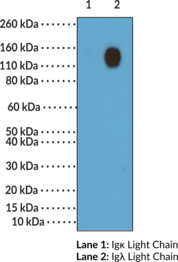Description
Igλ light chain is one type of light chain found in immunoglobulins, which are part of the immunoglobulin superfamily of glycoproteins that plays a central role in the adaptive immune response.{28520} Immunoglobulins are produced by B cells and later secreted by plasma cells as antibodies.{55225} They are composed of two heavy chains of approximately 50 kDa each and two light chains of approximately 25 kDa each.{28520} The heavy chains are linked together by disulfide bonds to form an Fc region and also combine with the light chains to form the Fab region, which mediate receptor and antigen binding, respectively.{55171} Mammalian immunoglobulins contain either Igκ or Igλ light chains each of which are composed of a constant and variable domain.{55225,28687} The ratio of Igκ to Igλ light chain containing antibodies varies between species, with ratios of 20:1, 2:1, and 1:20 in mice, humans, and cattle, respectively. In systemic amyloidosis, a clonal population of plasma cells produces light chains that form amyloid fibrils, and the type of free light chains (FLCs) produced is predominantly Igλ with an Igκ to Igλ ratio of 1:3 or, in amyloidosis patients with nephrotic-range proteinuria, 1:5.{52650} Cayman’s Igλ Light Chain (mouse) Rabbit Monoclonal Antibody can be used for ELISA and Western blot (WB; non-reducing conditions) applications. The antibody recognizes the Igλ light chain from mouse samples.
Synonyms: Immunoglobulin Lambda Light Chain|Immunoglobulin λ Light Chain
Immunogen: Mouse IgMλ
Formulation: 100 µg of protein A-purified monoclonal antibody
Isotype: IgG
Applications: ELISA, WB (non-reducing conditions)
Origin:
Stability: 365 days
Application|ELISA||Application|Western Blot||Product Type|Antibodies|Monoclonal Antibodies||Research Area|Cardiovascular System|Blood|Serum Proteins||Research Area|Immunology & Inflammation|Adaptive Immunity


